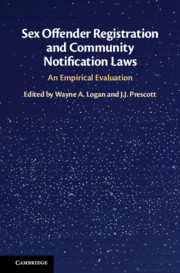Book contents
- Sex Offender Registration and Community Notification Laws: An Empirical Evaluation
- Sex Offender Registration and Community Notification Laws
- Copyright page
- Contents
- Contributors
- Preface
- Acknowledgments
- 1 Origins and Evolution
- 2 Variations in the Structure and Operation of SORN Systems
- 3 Registries and Registrants:
- 4 Law Enforcement and SORN
- 5 The Public and SORN Laws
- 6 The Ancillary Consequences of SORN
- 7 Offenders and SORN Laws
- 8 Integrating the Etiology of Sexual Offending into Evidence-Based Policy and Practices
- 9 Juvenile Registration and Notification Are Failed Policies That Must End
- Conclusion
- Index
- References
9 - Juvenile Registration and Notification Are Failed Policies That Must End
Published online by Cambridge University Press: 11 June 2021
- Sex Offender Registration and Community Notification Laws: An Empirical Evaluation
- Sex Offender Registration and Community Notification Laws
- Copyright page
- Contents
- Contributors
- Preface
- Acknowledgments
- 1 Origins and Evolution
- 2 Variations in the Structure and Operation of SORN Systems
- 3 Registries and Registrants:
- 4 Law Enforcement and SORN
- 5 The Public and SORN Laws
- 6 The Ancillary Consequences of SORN
- 7 Offenders and SORN Laws
- 8 Integrating the Etiology of Sexual Offending into Evidence-Based Policy and Practices
- 9 Juvenile Registration and Notification Are Failed Policies That Must End
- Conclusion
- Index
- References
Summary
Chapter 9 examines the consequences of subjecting children to SORN laws. It argues that registration and notification laws are uniquely ineffective and harmful when applied to children. The chapter begins with a history of how SORN laws came to regulate juvenile sexual misconduct. In response to moral panics around “sexual predators” and “juvenile super-predators,” policymakers explicitly expanded the scope of SORN laws to cover children adjudicated delinquent of sex offenses. The chapter next evaluates the effects of these laws on juvenile offending, particularly recidivism. Contrary to the myths underlying their enactment, children found to have engaged in sexual misconduct very rarely reoffend. Further, the evidence is unanimous that SORN laws do not reduce recidivism. The chapter then compiles evidence on the many deleterious effects SORN laws produce when they are applied to children. Studies of providers and children who are registrants demonstrate that SORN laws increase substantially the risk of suicide and sexual victimization. Furthermore, SORN laws are associated with high rates of plea bargaining among children. In light of these failures and dangerous effects, the application of SORN to children should be abandoned.
Keywords
- Type
- Chapter
- Information
- Sex Offender Registration and Community Notification LawsAn Empirical Evaluation, pp. 164 - 180Publisher: Cambridge University PressPrint publication year: 2021
References
References
Caselaw
Statute
- 2
- Cited by

